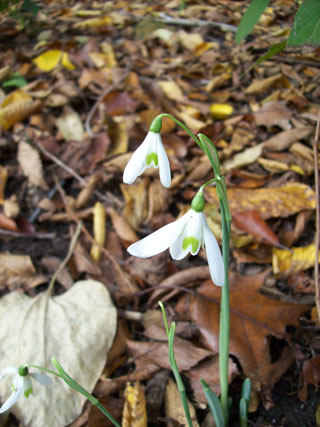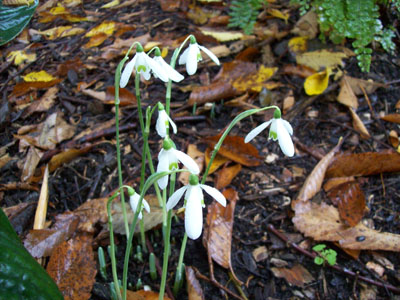
Much of the northeast suffered through a hot, humid and dry summer. While people often seek reprieve in an air-conditioned building; plants have their own coping mechanisms. Summer dormancy is not an uncommon occurrence for heat and drought stressed plants. The process, known as aestivation, is a survival mechanism found in numerous grasses, shrubs and tropicals growing in arid situations. Cooler temperatures and precipitation often break the dormancy. In some instances, a flush of bloom will occur.
I preface this article with that background information as I was certain that the galanthus, yes, galanthus, blooming in the Terry Shane Teaching Garden was confused. Surely the stifling summer followed by cool temperatures and generous precipitation had induced an early flush of flowers. This was not the case. Meet Galanthus reginae-olgae, the autumn snowdrop.
Snowdrops are harbingers of spring. The delicate looking bulbs erupt forth in January, February and March, often pushing through snow. Galanthus have gained a cult-like following. With numerous species and hundreds of cultivars, serious collectors abound. Dubbed galanthophiles, snow drop enthusiasts often go to great lengths to acquire the rare and unusual. According to Wikipedia, the term was probably first coined by the British plantsman and garden writer E.A. Bowles in a letter to his friend, another ardent collector of bulbs, whom he addressed as “Dear Galanthophil”.

Galanthus reginae-olgae photo credit: J. Coceano
Galanthus reginae-olgae is a true autumn blooming snowdrop. The flowers emerge before the foliage, usually in late October through November. It is native to the Balkan Peninsula in Europe where it was named after Queen Olga, member of the Russian imperial family. When planting, chose a location with good drainage that is not too shady or excessively dry. Snowdrops appreciate organic material added and grit is prescribed for heavy soils. Bear in mind that galanthus are best when sited close to a path or door, allowing the viewer to appreciate the small wonders.
Despite a great interest in snowdrops, many species and cultivars remain extremely rare in cultivation. This is due in part to their scarcity in commerce. Many retailers and garden catalogs like Brent and Becky’s Bulbs offer several of the more common galanthus. If interested in more obscure snowdrops, try joining a bulb or rock garden society. Many mail order companies exist overseas as well as small, independent U.S. suppliers exist.
A great resource for every galanthophil is the book Snowdrops by Matt Bishop, Aaron Davis and John Grimshaw, found in the Scott Arboretum Horticultural Library. A word of warning: flipping through this text is bound to lead one spending hours searching the web for these tiny jewels. Time well spent!
